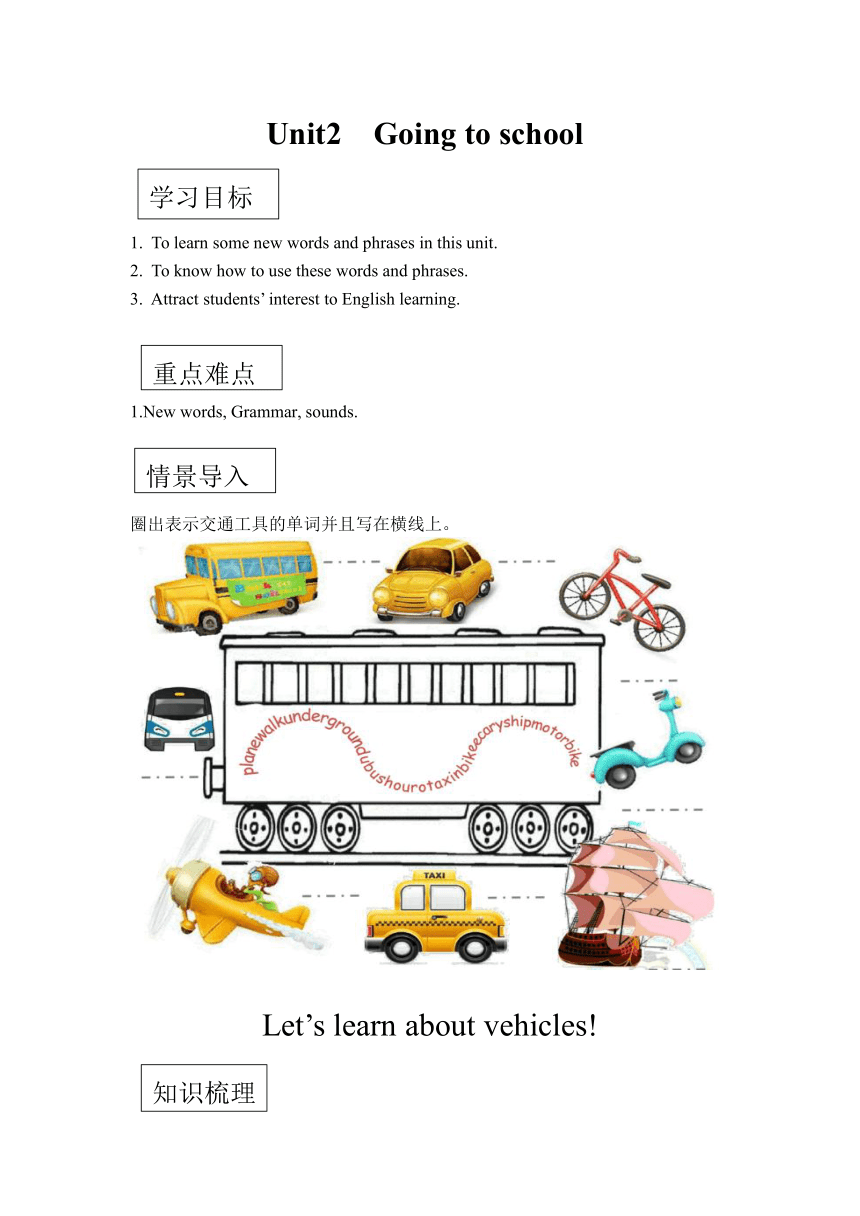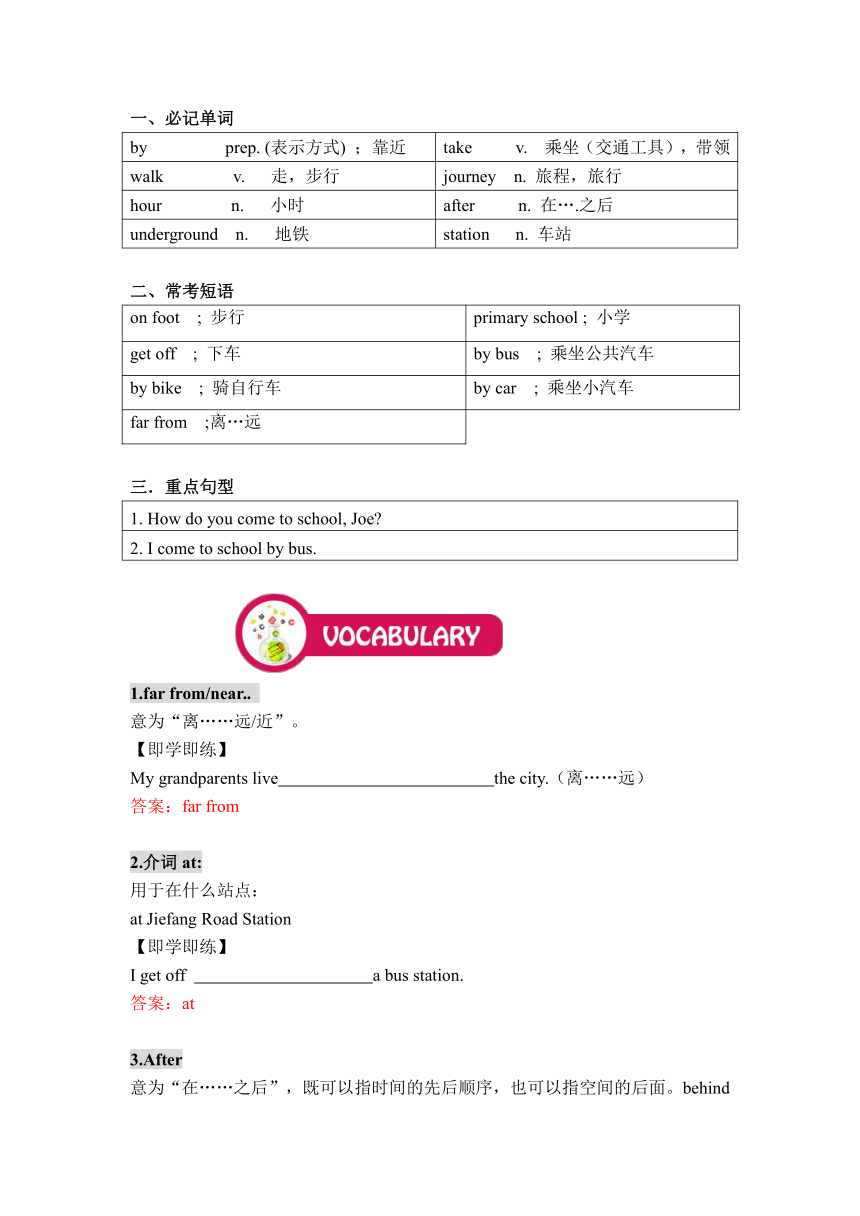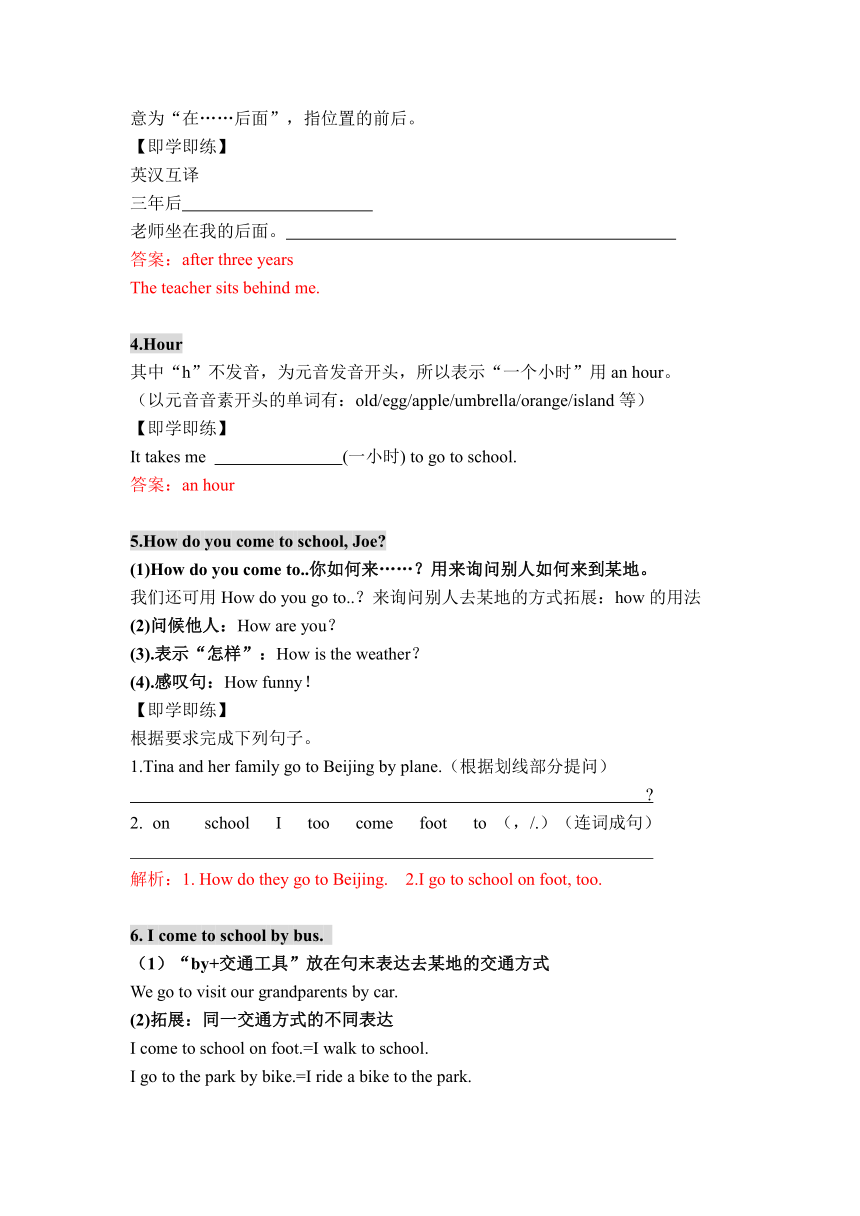Module 1 Unit 2 Going to school 学案(含答案)
文档属性
| 名称 | Module 1 Unit 2 Going to school 学案(含答案) |  | |
| 格式 | docx | ||
| 文件大小 | 571.8KB | ||
| 资源类型 | 教案 | ||
| 版本资源 | 牛津深圳版 | ||
| 科目 | 英语 | ||
| 更新时间 | 2020-08-19 09:11:52 | ||
图片预览



文档简介
70485572770学习目标
学习目标
Unit2 Going to school
Unit2 Going to school
To learn some new words and phrases in this unit.
To know how to use these words and phrases.
Attract students’ interest to English learning.
9906042545重点难点
重点难点
1.New words, Grammar, sounds.
41910204470情景导入
情景导入
圈出表示交通工具的单词并且写在横线上。
Let’s learn about vehicles!
99060159385知识梳理
知识梳理
一、必记单词
by prep. (表示方式) ;靠近
take v. 乘坐(交通工具),带领
walk v. 走,步行
journey n. 旅程,旅行
hour n. 小时
after n. 在….之后
underground n. 地铁
station n. 车站
二、常考短语
on foot ; 步行
primary school ; 小学
get off ; 下车
by bus ; 乘坐公共汽车
by bike ; 骑自行车
by car ; 乘坐小汽车
far from ;离…远
三.重点句型
1. How do you come to school, Joe?
2. I come to school by bus.
1.far from/near..
意为“离……远/近”。
【即学即练】
My grandparents live the city.(离……远)
答案:far from
2.介词at:
用于在什么站点:
at Jiefang Road Station
【即学即练】
I get off a bus station.
答案:at
3.After
意为“在……之后”,既可以指时间的先后顺序,也可以指空间的后面。behind意为“在……后面”,指位置的前后。
【即学即练】
英汉互译
三年后
老师坐在我的后面。
答案:after three years
The teacher sits behind me.
4.Hour
其中“h”不发音,为元音发音开头,所以表示“一个小时”用an hour。
(以元音音素开头的单词有:old/egg/apple/umbrella/orange/island等)
【即学即练】
It takes me (一小时) to go to school.
答案:an hour
5.How do you come to school, Joe?
(1)How do you come to..你如何来……?用来询问别人如何来到某地。
我们还可用How do you go to..?来询问别人去某地的方式拓展:how的用法
(2)问候他人:How are you?
(3).表示“怎样”:How is the weather?
(4).感叹句:How funny!
【即学即练】
根据要求完成下列句子。
1.Tina and her family go to Beijing by plane.(根据划线部分提问)
?
on school I too come foot to (,/.)(连词成句)
解析:1. How do they go to Beijing. 2.I go to school on foot, too.
6. I come to school by bus.
(1)“by+交通工具”放在句末表达去某地的交通方式
We go to visit our grandparents by car.
(2)拓展:同一交通方式的不同表达
I come to school on foot.=I walk to school.
I go to the park by bike.=I ride a bike to the park.
Danny goes to the museum by bus.=Danny takes a bus to the museum.
Tips:
on foot与walk的区别:
on foot是介词短语,表示方式,必频与实义动词连用:
walk是实又动词,表示动作,能单独用作谓语
I walk to the park=I go to the park on foot.
【即学即练】
Susan a bus Spring Street.(乘坐)
2.(同义句)
答案:1. takes; to 2. Susan goes to Spring Street by bus.
第三人称单数
一般现在时的构成有两种:
句中有be动词: “主人公+be(am ,is ,are)+其它”。
如:I am a boy.我是一个男孩。
2. 句中没有be动词,是行为动词时: “主人公+行为动词(+其它)”。
如:We study English.我们学习英语。
He often plays football after school.
Kitty has many books.
注意:当主语为第三人称单数时,动词使用三单形式:
第三人称单数:不是I,不是you,并且只有一个。
动词变为三单形式的常见规则:
1. 一般情况下,直接在动词词尾+s,读音规则:清后清,浊后浊。例如:get→gets;take→takes。
2. 以s, sh, ch, x结尾的动词,在词尾+ es,例如:teach→ teaches; fix→fixes; go→goes。
3. 以辅音字母+ y 结尾的动词,变y 为i,再+ es,如:study→ studies; try→tries。
4. 以o结尾的动词,直接+es,如:do→does。
5. have的三单形式为has。
【即学即练】
1、 写出下列动词的第三人称单数
drink__________ go __________ stay __________ make ___________
look___________ have__________ pass___________ carry___________
2、用括号内动词的适当形式填空。
(1). He often ____________ (have) dinner at home.
(2). Daniel and Tommy _______________ (be) in Class One.
(3). We _______________ (watch) TV on Monday.
(4). Nick_______________ ( go) to the zoo on Sunday.
答案:1.drinks goes stays makes looks has passes carries
2.(1)has (2)are (3)watch (4)goes
语音
sp [sp] wasp crisp grasp clasp
拓展:
以sp开头的单词,清辅音[p]要浊化为[b],如:spider、speak、space。
【常考题】
读一读,选出划线部分发音与其他选项不同的选项,并填入括号中。
( )A.grasp B.wasp C.sport D.clasp
解析:
本题考查字母组合sp的发音。如题,sport中以sp开头,清辅音[p]
要发浊化为[b],A、B、D选项中sp发音均为[sp],故选C。
答案:C
【即学即练】
I.读一读,判断下列单词划线部分读音是“T”否“F”相同。
1.( ) 2.( ) 3.( ) 4.( ) 5.( )
speak skate grasp tall spring
special task wasp roll sport
spell mask desk mall crisp
解析:1. T 2.F 3.F 4.T 5.F
综合练习
一.英汉互译
1.bus stop 2.on foot
3.来到学校 4.乘坐火车
5. 下车 6.半个小时后
7. 步行 8. 乘坐校车
二.读一读,连一连。
1.How do you come to school? A.No,he doesn't.
2.How does Lisa go to school? B.I come to school by bike.
3.Does Tim live far from his school? C.She goes to school by bus.
4.How does she go to work? D.Yes,I do.
5.Do you go to Beijing by plane? E.She goes to work by car.
解析:
一.1.公交车站 2.步行 3.come to school 4.by train
5.get off 6.after half an hour 7.on foot 8.by school bus
二.1. B 2. C 3. A 4. E 5. D
3810235585巩固提高
巩固提高
一.读一读,选择下列句子的同义句。
( ) 1. I come to school on foot.
A.I walk to school.
B. I come to school by bike
C. I like my school.
( ) 2. They go to the park by taxi.
A.They take a taxi to the park.
B. They take bus to the park.
C. They go to the park by car.
( ) 3. She goes to the zoo by bike.
A.She rides a bike to the zoo.
B. She can ride a bike.
C. I like bikes.
二.根据所给情景选出适当的问句或答语
( )1. –How do you go to school? -- ________.
A.I walk to school B. She likes her school C. I live near school
( ) 2. -- _______ -- He goes to work by underground.
A.How old is he? B. How are you? C. How does he go to work?
( ) 3. –Do you go to Beijing by plane? -- ________.
A.Yes, I do. B. No, he doesn’t. C. Yes, there is.
( ) 4. -- _____ --Yes, she does. She goes to work by car.
A. Do you like it?
B. Does she go to work by car?
C. What is it?
三.完形填空
Mr. Brown lives (1)_____Red Street. It is far from his office. There is a bus stop near his office. There is a bus stop near his home. He (2)_____ to the bus stop every morning. He (3)_____ Bus No.10.(4)_____ half an hour, he gets off (5)_____ Blue Street Bus Stop. Then he walks to his office.
( )1. A. on B. a C. to
( )2. A. walk B. walks C. walking
( )3. A. take B. takes C. taking
( )4. A. Before B. And C. After
( )5. A. at B. to C. in
解析:一. 1.A 2.A 3. A
二.1.A 2. C 3. A 4. B
三.1-5: A B B C A.
3238533020课堂总结
课堂总结
一、必记单词
by prep. (表示方式) ;靠近
take v. 乘坐(交通工具),带领
walk v. 走,步行
journey n. 旅程,旅行
hour n. 小时
after n. 在….之后
underground n. 地铁
station n. 车站
二、常考短语
on foot 步行
primary school 小学
get off 下车
by bus 乘坐公共汽车
by bike 骑自行车
by car 乘坐小汽车
far from 离…远
学习目标
Unit2 Going to school
Unit2 Going to school
To learn some new words and phrases in this unit.
To know how to use these words and phrases.
Attract students’ interest to English learning.
9906042545重点难点
重点难点
1.New words, Grammar, sounds.
41910204470情景导入
情景导入
圈出表示交通工具的单词并且写在横线上。
Let’s learn about vehicles!
99060159385知识梳理
知识梳理
一、必记单词
by prep. (表示方式) ;靠近
take v. 乘坐(交通工具),带领
walk v. 走,步行
journey n. 旅程,旅行
hour n. 小时
after n. 在….之后
underground n. 地铁
station n. 车站
二、常考短语
on foot ; 步行
primary school ; 小学
get off ; 下车
by bus ; 乘坐公共汽车
by bike ; 骑自行车
by car ; 乘坐小汽车
far from ;离…远
三.重点句型
1. How do you come to school, Joe?
2. I come to school by bus.
1.far from/near..
意为“离……远/近”。
【即学即练】
My grandparents live the city.(离……远)
答案:far from
2.介词at:
用于在什么站点:
at Jiefang Road Station
【即学即练】
I get off a bus station.
答案:at
3.After
意为“在……之后”,既可以指时间的先后顺序,也可以指空间的后面。behind意为“在……后面”,指位置的前后。
【即学即练】
英汉互译
三年后
老师坐在我的后面。
答案:after three years
The teacher sits behind me.
4.Hour
其中“h”不发音,为元音发音开头,所以表示“一个小时”用an hour。
(以元音音素开头的单词有:old/egg/apple/umbrella/orange/island等)
【即学即练】
It takes me (一小时) to go to school.
答案:an hour
5.How do you come to school, Joe?
(1)How do you come to..你如何来……?用来询问别人如何来到某地。
我们还可用How do you go to..?来询问别人去某地的方式拓展:how的用法
(2)问候他人:How are you?
(3).表示“怎样”:How is the weather?
(4).感叹句:How funny!
【即学即练】
根据要求完成下列句子。
1.Tina and her family go to Beijing by plane.(根据划线部分提问)
?
on school I too come foot to (,/.)(连词成句)
解析:1. How do they go to Beijing. 2.I go to school on foot, too.
6. I come to school by bus.
(1)“by+交通工具”放在句末表达去某地的交通方式
We go to visit our grandparents by car.
(2)拓展:同一交通方式的不同表达
I come to school on foot.=I walk to school.
I go to the park by bike.=I ride a bike to the park.
Danny goes to the museum by bus.=Danny takes a bus to the museum.
Tips:
on foot与walk的区别:
on foot是介词短语,表示方式,必频与实义动词连用:
walk是实又动词,表示动作,能单独用作谓语
I walk to the park=I go to the park on foot.
【即学即练】
Susan a bus Spring Street.(乘坐)
2.(同义句)
答案:1. takes; to 2. Susan goes to Spring Street by bus.
第三人称单数
一般现在时的构成有两种:
句中有be动词: “主人公+be(am ,is ,are)+其它”。
如:I am a boy.我是一个男孩。
2. 句中没有be动词,是行为动词时: “主人公+行为动词(+其它)”。
如:We study English.我们学习英语。
He often plays football after school.
Kitty has many books.
注意:当主语为第三人称单数时,动词使用三单形式:
第三人称单数:不是I,不是you,并且只有一个。
动词变为三单形式的常见规则:
1. 一般情况下,直接在动词词尾+s,读音规则:清后清,浊后浊。例如:get→gets;take→takes。
2. 以s, sh, ch, x结尾的动词,在词尾+ es,例如:teach→ teaches; fix→fixes; go→goes。
3. 以辅音字母+ y 结尾的动词,变y 为i,再+ es,如:study→ studies; try→tries。
4. 以o结尾的动词,直接+es,如:do→does。
5. have的三单形式为has。
【即学即练】
1、 写出下列动词的第三人称单数
drink__________ go __________ stay __________ make ___________
look___________ have__________ pass___________ carry___________
2、用括号内动词的适当形式填空。
(1). He often ____________ (have) dinner at home.
(2). Daniel and Tommy _______________ (be) in Class One.
(3). We _______________ (watch) TV on Monday.
(4). Nick_______________ ( go) to the zoo on Sunday.
答案:1.drinks goes stays makes looks has passes carries
2.(1)has (2)are (3)watch (4)goes
语音
sp [sp] wasp crisp grasp clasp
拓展:
以sp开头的单词,清辅音[p]要浊化为[b],如:spider、speak、space。
【常考题】
读一读,选出划线部分发音与其他选项不同的选项,并填入括号中。
( )A.grasp B.wasp C.sport D.clasp
解析:
本题考查字母组合sp的发音。如题,sport中以sp开头,清辅音[p]
要发浊化为[b],A、B、D选项中sp发音均为[sp],故选C。
答案:C
【即学即练】
I.读一读,判断下列单词划线部分读音是“T”否“F”相同。
1.( ) 2.( ) 3.( ) 4.( ) 5.( )
speak skate grasp tall spring
special task wasp roll sport
spell mask desk mall crisp
解析:1. T 2.F 3.F 4.T 5.F
综合练习
一.英汉互译
1.bus stop 2.on foot
3.来到学校 4.乘坐火车
5. 下车 6.半个小时后
7. 步行 8. 乘坐校车
二.读一读,连一连。
1.How do you come to school? A.No,he doesn't.
2.How does Lisa go to school? B.I come to school by bike.
3.Does Tim live far from his school? C.She goes to school by bus.
4.How does she go to work? D.Yes,I do.
5.Do you go to Beijing by plane? E.She goes to work by car.
解析:
一.1.公交车站 2.步行 3.come to school 4.by train
5.get off 6.after half an hour 7.on foot 8.by school bus
二.1. B 2. C 3. A 4. E 5. D
3810235585巩固提高
巩固提高
一.读一读,选择下列句子的同义句。
( ) 1. I come to school on foot.
A.I walk to school.
B. I come to school by bike
C. I like my school.
( ) 2. They go to the park by taxi.
A.They take a taxi to the park.
B. They take bus to the park.
C. They go to the park by car.
( ) 3. She goes to the zoo by bike.
A.She rides a bike to the zoo.
B. She can ride a bike.
C. I like bikes.
二.根据所给情景选出适当的问句或答语
( )1. –How do you go to school? -- ________.
A.I walk to school B. She likes her school C. I live near school
( ) 2. -- _______ -- He goes to work by underground.
A.How old is he? B. How are you? C. How does he go to work?
( ) 3. –Do you go to Beijing by plane? -- ________.
A.Yes, I do. B. No, he doesn’t. C. Yes, there is.
( ) 4. -- _____ --Yes, she does. She goes to work by car.
A. Do you like it?
B. Does she go to work by car?
C. What is it?
三.完形填空
Mr. Brown lives (1)_____Red Street. It is far from his office. There is a bus stop near his office. There is a bus stop near his home. He (2)_____ to the bus stop every morning. He (3)_____ Bus No.10.(4)_____ half an hour, he gets off (5)_____ Blue Street Bus Stop. Then he walks to his office.
( )1. A. on B. a C. to
( )2. A. walk B. walks C. walking
( )3. A. take B. takes C. taking
( )4. A. Before B. And C. After
( )5. A. at B. to C. in
解析:一. 1.A 2.A 3. A
二.1.A 2. C 3. A 4. B
三.1-5: A B B C A.
3238533020课堂总结
课堂总结
一、必记单词
by prep. (表示方式) ;靠近
take v. 乘坐(交通工具),带领
walk v. 走,步行
journey n. 旅程,旅行
hour n. 小时
after n. 在….之后
underground n. 地铁
station n. 车站
二、常考短语
on foot 步行
primary school 小学
get off 下车
by bus 乘坐公共汽车
by bike 骑自行车
by car 乘坐小汽车
far from 离…远
同课章节目录
- Module 1 Getting to know each othe
- Unit 1 My future
- Unit 2 Going to school
- Unit 3 My birthday
- Revision 1
- Project 1
- Module 2 Relationships
- Unit 4 Grandparents
- Unit 5 Friends
- Unit 6 Family life
- Revision 2
- Project 2
- Module 3 Out and about
- Unit 7 At the beach
- Unit 8 An outing
- Unit 9 Around the city
- Revision 3
- Project 3
- Module 4 The natural world
- Unit 10 Wind
- Unit 11 Wate
- Unit 12 Fire
- Revision 4
- Project 4
